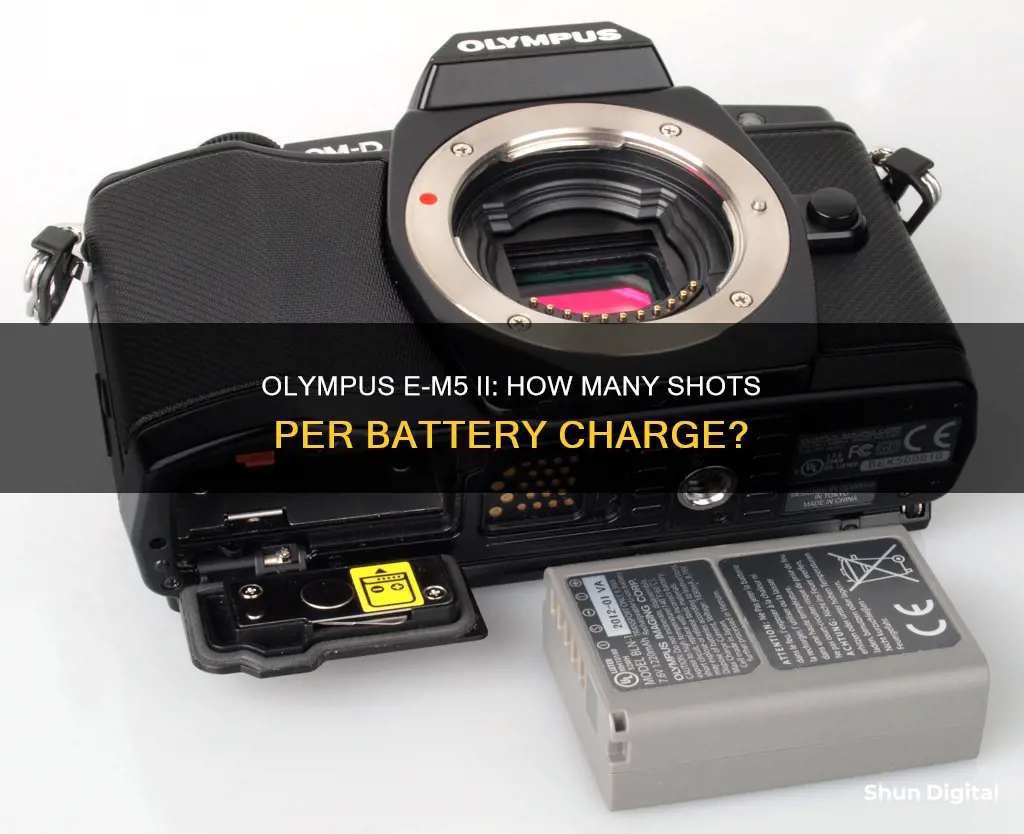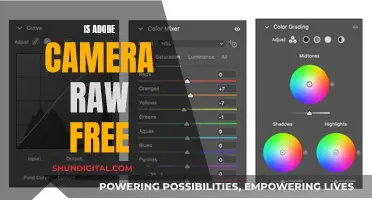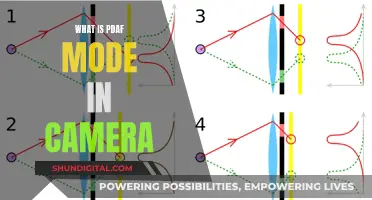
The Olympus OM-D E-M5 II is a mirrorless interchangeable lens camera that features a 15.9MP sensor. It is powered by the Olympus BLN-1, a rechargeable lithium-ion battery pack. The number of shots that can be taken with a fully charged battery depends on the style and imaging practice of the photographer. According to the Camera & Imaging Products Association (CIPA), the E-M5 II can take 310 images on a single charge.
| Characteristics | Values |
|---|---|
| Battery | Olympus BLN-1 |
| Battery type | Rechargeable Lithium-Ion power pack |
| Compatibility | Olympus E-M5 II & other selected Olympus cameras |
| Number of shots (CIPA) with the Olympus E-M5 II | 310 |
| Voltage | 7.6V |
| Capacity | 1220mAh |
| Width | 36mm |
| Height | 15mm |
| Depth | 50mm |
| Weight | 52g |
What You'll Learn
- The Olympus OM-D E-M5 II is a mirrorless camera with a 15.9MP sensor
- The camera's battery life is rated at 310 shots per charge
- The E-M5 II's movie capabilities have been enhanced with the addition of 1080/60p shooting and an All-I, 77Mbps compression option for 30p capture
- The Olympus OM-D E-M5 II is a small, attractive and usable 16MP camera
- The E-M5 II is rated at 310 shots per charge, down from 360 shots for the original camera

The Olympus OM-D E-M5 II is a mirrorless camera with a 15.9MP sensor
The camera has a durable, all-metal body that is weather-sealed, making it splashproof, dustproof, and freezeproof. It features a 5-axis voice coil motor image stabilization system, which reduces blur caused by camera shake. The E-M5 II also has a fast autofocus system and a large 2.35 million dot electronic viewfinder.
In terms of customization, the camera is highly versatile, with almost every button being reprogrammable. It has a range of shooting modes, including Program, Shutter Priority, Aperture Priority, and Manual. The E-M5 II also supports various file formats, including JPEG, Raw, and MPO (3D).
The camera uses a rechargeable Lithium-Ion battery pack, which can be charged via a standard electrical outlet. According to the Camera & Imaging Products Association (CIPA), the E-M5 II can capture approximately 310 images on a single charge. However, this may vary depending on usage, such as frequent use of the LCD screen.
The Olympus OM-D E-M5 II is a well-built and versatile camera that offers a range of features and produces high-quality images. It is a great option for photographers who want a lightweight and portable camera without compromising on performance and image quality.
Motorola Focus 66: How Long Does the Charge Last?
You may want to see also

The camera's battery life is rated at 310 shots per charge
The Olympus OM-D E-M5 II is a mirrorless interchangeable lens camera that can take 310 images on a single charge, according to the Camera & Imaging Products Association (CIPA) rating. This is a decrease from the original OM-D E-M5, which was rated at 360 shots per charge.
The number of shots that can be taken from a single charge depends on a variety of factors, including the photographer's style and imaging practice. For example, heavy use of the LCD screen for framing or reviewing images will result in reduced battery performance. Cold environments, frequent turning on and off of the camera, and age of the battery pack can also decrease the number of shots that can be taken.
The OM-D E-M5 II is powered by the Olympus BLN-1, a rechargeable lithium-ion battery pack. The BLN-1 operates at a voltage of 7.6V and has a capacity of 1220mAh. It can be charged from a standard electrical outlet via the Olympus BCN-1 charger, which can be purchased separately. The battery pack measures 36mm in width, 15mm in height, and 50mm in depth, and weighs 52g.
The OM-D E-M5 II is a 15.9MP camera with a variety of features, including a tilting OLED touchscreen display, improved 5-axis image stabilization, and 10fps continuous shooting. It is a small, attractive, and usable camera, with a magnesium alloy body that is dustproof and splashproof.
Charging the HP R847: A Step-by-Step Guide
You may want to see also

The E-M5 II's movie capabilities have been enhanced with the addition of 1080/60p shooting and an All-I, 77Mbps compression option for 30p capture
The E-M5 II's movie capabilities have been enhanced with the addition of 1080/60p shooting, which is a higher frame rate than the previous model. This means that the camera can capture smoother and more detailed video, which is ideal for fast-paced or action scenes. The All-I compression option for 30p capture offers a higher bitrate and, therefore, better quality video. This is great for filming scenes with a lot of movement or detail.
The E-M5 II also includes a number of other enhancements to its movie capabilities, such as focus peaking, which highlights the edges of objects in focus to make it easier for the camera to track them. It also has uncompressed HDMI output, which allows for higher-quality video recording and a mic input socket for better audio capture. Additionally, the timecode feature ensures that the audio and video are synchronised, making it easier to edit the footage.
Overall, the E-M5 II offers improved movie capabilities that will appeal to both amateur and professional videographers. The addition of 1080/60p shooting and an All-I, 77Mbps compression option for 30p capture enhances the camera's video performance and provides more flexibility for different types of scenes and subjects.
The Rebel T6 Camera Battery: How Long Does It Last?
You may want to see also

The Olympus OM-D E-M5 II is a small, attractive and usable 16MP camera
The Olympus OM-D E-M5 II is a compact, mirrorless camera with a 16MP sensor. It is small, attractive, and easy to use, with a range of features that make it a good choice for photographers of all skill levels.
The E-M5 II has a well-built, weather-sealed body and offers excellent image quality and image stabilization. It has a fast autofocus system and can shoot at up to 9 frames per second. The camera also has a built-in electronic viewfinder and a tilting OLED touchscreen display.
The E-M5 II uses a rechargeable Lithium-Ion battery pack, which offers high energy density and low self-discharge. The battery can be charged from a standard electrical outlet using the Olympus BCN-1 charger (sold separately). According to the Camera & Imaging Products Association (CIPA) rating, the E-M5 II can take 310 images on a single charge. However, the actual number of shots may vary depending on factors such as the use of the LCD screen, temperature, and frequency of turning the camera on and off.
The E-M5 II is a versatile and capable camera, offering a good balance of features and performance for both enthusiasts and professional photographers.
USB Camera Chargers: What's the Deal?
You may want to see also

The E-M5 II is rated at 310 shots per charge, down from 360 shots for the original camera
The Olympus OM-D E-M5 II is a mirrorless interchangeable lens camera that features a 15.9MP sensor. The camera is powered by the Olympus BLN-1, a rechargeable lithium-ion battery pack. The battery operates at a voltage of 7.6V and has a capacity of 1220mAh. The E-M5 II can take 310 images on a single charge, according to the Camera & Imaging Products Association (CIPA). This is a decrease from the original Olympus OM-D E-M5 camera, which could capture 360 images on a single charge.
The number of shots that can be captured on a single charge depends on the style and imaging practice of the photographer. For example, heavy use of the LCD screen for framing or reviewing images will result in reduced battery performance. Additionally, factors such as cold environments, frequent turning on and off of the camera, and age of the battery pack can also impact battery performance and result in a lower number of shots per charge.
Charging Your Alto Camera: A Quick Guide
You may want to see also
Frequently asked questions
The number of shots that can be taken with a fully charged E-M5 II battery depends on the style and imaging practice of the photographer. The Camera & Imaging Products Association (CIPA) has established guidelines that manufacturers are supposed to respect when reporting the battery life of their cameras. According to this CIPA-rating, the Olympus E-M5 II can take 310 images on a single charge.
The E-M5 II is rated at 310 shots per charge, down from 360 shots for the original camera.
The E-M5 II and E-M5 III are rated to take the same number of shots per charge (310).
The E-M5 II is rated to take 310 shots per charge, while the E-M1 is rated to take 440 shots per charge.
The E-M5 II is rated to take 310 shots per charge, while the E-M10 is rated to take 320 shots per charge.







